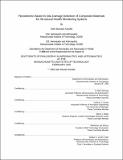| dc.contributor.advisor | S. Mark Spearing. | en_US |
| dc.contributor.author | Kessler, Seth Stovack, 1977- | en_US |
| dc.contributor.other | Massachusetts Institute of Technology. Dept. of Aeronautics and Astronautics. | en_US |
| dc.date.accessioned | 2005-05-19T14:58:06Z | |
| dc.date.available | 2005-05-19T14:58:06Z | |
| dc.date.copyright | 2002 | en_US |
| dc.date.issued | 2002 | en_US |
| dc.identifier.uri | http://hdl.handle.net/1721.1/16836 | |
| dc.description | Thesis (Ph. D.)--Massachusetts Institute of Technology, Dept. of Aeronautics and Astronautics, 2002. | en_US |
| dc.description | Includes bibliographical references (p. 151-160). | en_US |
| dc.description | This electronic version was submitted by the student author. The certified thesis is available in the Institute Archives and Special Collections. | en_US |
| dc.description.abstract | Cost-effective and reliable damage detection is critical for the utilization of composite materials. This thesis presents the conclusions of an analytical and experimental survey of candidate methods for in-situ damage detection in composite materials. Finite element results are presented for the application of modal analysis and Lamb wave techniques to quasi-isotropic graphite/epoxy test specimens containing representative damage. These results were then verified experimentally by using piezoelectric patches as actuators and sensors for both sets of experiments. The passive modal analysis method was reliable for detecting small amounts of global damage in a simple composite structures. By comparison, the active Lamb wave method was sensitive to all types of local damage present between the sensor and actuator, provided useful information about damage presence and severity, and presents the possibility of estimating damage type and location. Analogous experiments were also performed for more complex built-up structures such as sandwich beams, stiffened plates and composite cylinders. | en_US |
| dc.description.abstract | (cont.) These techniques have proven suitable for structural health monitoring applications since they can be applied with low power conformable sensors and can provide useful information about the state of a structure during operation. Piezoelectric patches could also be used as multipurpose sensors to test using a variety of methods such as modal analysis, Lamb wave, acoustic emission and strain based methods simultaneously by altering driving frequencies and sampling rates. Guidelines and recommendations drawn from this research are presented to assist in the design of a structural health monitoring system for a vehicle, and provides a detailed example of a SHM system architecture. These systems will be an important component in future designs of air and spacecraft to increase the feasibility of their missions. | en_US |
| dc.description.statementofresponsibility | by Seth Stovack Kessler. | en_US |
| dc.format.extent | 200 p. | en_US |
| dc.format.extent | 3528101 bytes | |
| dc.format.extent | 3527858 bytes | |
| dc.format.mimetype | application/pdf | |
| dc.format.mimetype | application/pdf | |
| dc.language.iso | eng | en_US |
| dc.publisher | Massachusetts Institute of Technology | en_US |
| dc.rights | M.I.T. theses are protected by copyright. They may be viewed from this source for any purpose, but reproduction or distribution in any format is prohibited without written permission. See provided URL for inquiries about permission. | en_US |
| dc.rights.uri | http://dspace.mit.edu/handle/1721.1/7582 | |
| dc.subject | Aeronautics and Astronautics. | en_US |
| dc.title | Piezoelectric-based in-situ damage detection of composite materials for structural health monitoring systems | en_US |
| dc.type | Thesis | en_US |
| dc.description.degree | Ph.D. | en_US |
| dc.contributor.department | Massachusetts Institute of Technology. Department of Aeronautics and Astronautics | |
| dc.identifier.oclc | 51283592 | en_US |
